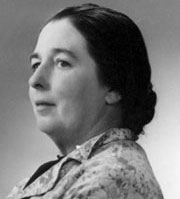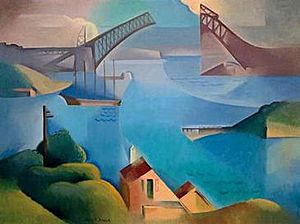Dorrit Black facts for kids
Quick facts for kids
Dorrit Black
|
|
|---|---|
 |
|
| Born |
Dorothea Foster Black
23 December 1891 |
| Died | 13 September 1951 (aged 59) |
| Occupation | Artist |
Dorrit Black (born Dorothea Foster Black, 1891–1951) was an amazing Australian artist. She was a talented painter and printmaker. Dorrit is famous for being a pioneer of Modernism in Australia. Modernism was a new and exciting art style. Sadly, she died in a car accident in 1951. She was 59 years old.
Contents
Early Life and Art Training
Dorrit Black was born in Burnside, South Australia. Her father, Alfred Barham Black, was an engineer and architect. Her mother, Jessie Howard Clark, was an amateur artist. Dorrit loved art from a young age.
She studied art at the South Australian School of Arts and Crafts around 1909. There, she focused on painting with watercolours. In 1915, she went to the Julian Ashton Art School in Sydney. Here, she learned to paint with oils.
Studying in Europe
In 1927, Dorrit traveled to London by herself. She attended the Grosvenor School of Modern Art. This is where she started experimenting with linocut printing. She learned from an artist named Claude Flight. He taught her to use bold, geometric shapes and bright colors.
In 1928, she went to Paris, France. She studied at André Lhote's Academy. Lhote taught her about using geometric shapes in her art. In 1929, she also worked briefly with Albert Gleizes.
Dorrit was greatly influenced by the Modernist and Cubist art movements. These were new and exciting styles in Europe. When she returned to Australia in late 1929, she brought these styles with her. She became a strong supporter of the Cubist style. In 1930, she had an art show in Sydney. This was one of many shows she would have.
The Modern Art Centre
Dorrit Black wanted to help other artists explore new styles. In 1931, she opened the Modern Art Centre in Sydney. This was the first art gallery in Australia dedicated to modern art. It was also one of the first galleries in Australia started by a woman.
Over the next few years, the Modern Art Centre became very important. It inspired many artists to try new things. It hosted small but important exhibitions. Artists like Roland Wakelin and Grace Cossington Smith showed their work there. These artists became key figures in Australian modern art.
Her Famous Artworks
Dorrit Black made most of her linocuts in the 1930s. Linocuts are prints made from carved linoleum. She captured the energy of the modern world in her prints. Later, she focused on watercolours and then returned to oils.
She moved to Adelaide in the late 1930s to live with her mother. There, she painted many landscapes. These showed the beautiful Adelaide hills and the south coast.
The Sydney Harbour Bridge
Dorrit is especially known for her paintings of the Sydney Harbour Bridge. She painted it while it was being built. Her painting The Bridge (1930) is very famous. It uses bright, jewel-like colors. This painting is considered Australia’s first Cubist landscape.
In 1931, Dorrit Black was a finalist for the Archibald Prize. This is a major award for portrait painting. The Art Gallery of South Australia bought her painting Mirmande (1928) in 1940.
After returning to Adelaide, Dorrit taught art part-time. She was also a member of important art societies. These included the South Australian Society of Arts and the Contemporary Art Society. Dorrit Black passed away in 1951 after a car accident.
Her Impact and Recognition
Women artists were very important in bringing Modernism to Australia. Dorrit Black is recognized as a key person. She helped Australians learn to appreciate modern art.
An art critic named Ivor Francis described her work. He said she was "deeply respected" by informed artists. He also noted that she faced challenges. People sometimes found her art too "modern." But he believed her talent would be appreciated in the future.
Dorrit Black's art is displayed in many important collections. You can find her work at the National Gallery of Australia. Her art is also in many state and regional galleries. The Victoria and Albert Museum in London also has her pieces.
The Art Gallery of South Australia organized a special exhibition of her work in 1975. They held another major show in 2014. Her work was also featured in the National Gallery of Australia's "Know My Name" exhibition in 2020.
See also
 In Spanish: Dorrit Black para niños
In Spanish: Dorrit Black para niños


